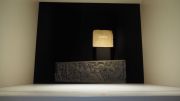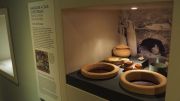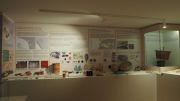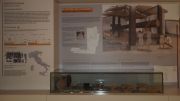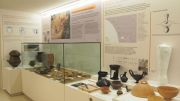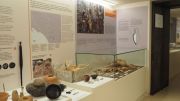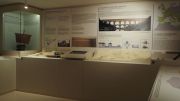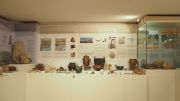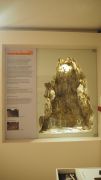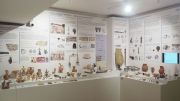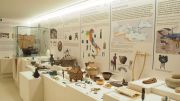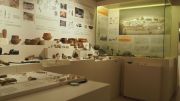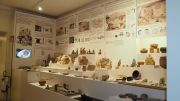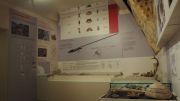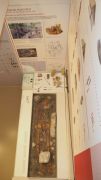In this corridor there are four niches dedicated to four cultural aspects very important for Roman society: the death, the religion, the cuisine and the domus.
Concerning the death, there is a Roman epigraph of a local noblewoman named Valeria Camilla, and the reproduction of a sarcophagus of the 3rd century A.D. that is now stored in Pieve di Camaiore, both findings come from Lombrici (Camaiore).
On the other side there is a reflection on Roman religiosity, that has to face the delicate transition from a Pagan religion, where the gods didn’t care about the human beings, to the Christian religion,
where the humans become the protagonists.
Mysterious religious practices taken from Greeks and the East promote these processes, that are based on a close relationship between the god and the devote person. This relationship starts with an initiation ritual and the oath of secrecy. In this niche there are also: a small “lararium” and other musical instruments used during religious rituals. We can hears the sounds of this ancient instruments.
This niche, instead, reproduce the termopolium of Pompei: food in Roman world represents a very important element: it’s a symbol of wellness and of high social status, but also an occasion of meeting and debate among common people.
The main course was the dinner, that rich families used to have while laying on the triclinium, served by slaves.
However it was a common thing also to eat out, buying food in bakeries, or shops that sold wine and cereals’ soups, or in tabernae, small taverns.
The last niche is dedicated to the domus‘ luxury, through richly decorated rooms with paintings in “false architecture” style. In the niche there are reconstructions of objects and instruments used in the important moment of otium, that is the pause taken from political commitments.
They spend their time playing with dices and pawns.
There are pottery and glass containers for the banquet, and musical instruments.
Romans people are experts in territorial divisions and develop more and more complex techniques to build streets, cities and public buildings that last for the centuries to come.
These two big scale models reconstruct various typologies of aqueduct and the distribution of water to the various buildings of the Roman city.
They specialize in the production of cereals, oil and wine, that they trade through the Mediterranean area, through big cargo ships with loads of amphoras, as we can observe in the showcase reconstruction.
They elaborate a complex system of harbors along the Italian peninsula in order to make safe and quick maritime movements (Ostia, Pozzuoli, Portus Pisanus…).
There are numerous materials coming from the Roman farm of Acquarella (Camaiore) that highlights the big productivity of this oil implants with crusher and attached storehouses, whose activity continues without interruption from the 2nd century B.C. to the 5th century A.D..
Concerning the residential area, in Massaciuccoli (Massarosa) there is a thermal implant with a mansio (an official stopping place on a Roman road with reception facilities) that have an attached thermal implant, with a precious mosaic representing a marine theme.
Here are displayed also amphoras and coins founded in our territory, reproduction of various Roman writing techniques (wax tablets, parchment and papyrus), blown glass, ornaments and pottery in “Terra sigillata”, a crystalline red shiny coating with matrix decorations.
In addition to the technological revolution linked to the use of the iron, a new metal used for the realization of weapons and very durable tools, this room offers an overview on the development of the big colonizer civilizations as Phoenicia and Greeks, that promoted the cultural evolution of numerous Italic populations.
Italic populations base their economy on breeding, agriculture and exploiting of mineral resources.
Their cultures was very different but always influenced by Greece and the East.
So noble groups started to adopt rituals such as banquets, symposium and exchange of gifts between leaders.
In this showcase there is the reconstruction of an Etruscan sailing ship used for the trade;
behind it there are the reconstructions of two hulls cutaways, one built with the technique with “mortise and tenons”, the other on with the “sewn” technique.
The Etruscan presence in Versilia is very strong: from San Rocchino (Massarosa) come objects imported from Southern Etruria and from Greece, confirming the function of this area both as an emporium and as arriving point.
Here are displayed the most significant potteries (for example, bucchero, black ceramic, and dolium), together with the finds coming from small Etruscan living centers in Camaiore's territory (Marignana, Acquarella). There are numerous reproductions of buccheros and potteries from living centers and burials in Versilia.
In Hellenistic Age, the Apuan territory is populated from Apuan-Ligurians, but that were in a constant interchange with Etruscan and Roman populations, as proven by the burials in cases made of stone from Vado (Camaiore), and numerous metal materials and amphoras coming from occasional recoveries in mountainous areas.
There are also many others objects from the Etruscan civilization such as metal fibulas, hut-made cinerary urns and bucchero ceramic. Furthermore you can experience the writing on the wax tablet.
This room is dedicated to the Age of the metals and here are illustrated the principal civilities of the Mediterranean area and of Near East (Sumerians, Egyptians, Assyro-Babylonians, Aegean and Cypriot societies).
In this room we can also observe the first process of bronze casting, the first forms of writing, musical instruments from Sumerian and Egyptian areas.
Regarding Italy, we can follow the evolution in in Age of Copper and Bronze, with reconstruction of numerous pottery vessels and bones, stone and flint objects and some cast of statue-stele from Lunigiana.
Here there is a 3D reconstruction from Age of Copper period in North-Eastern Tuscany: it’s a skull with signs of drilling in Grotta delle Pianacce. Moreover there are finds from a funerary kit in a karstic swallow hole of Buca del Corno (Camaiore), during the Eneolithic period.
Here there are some pottery finds from Bronze Age in Ripari di Candalla (Camaiore), and also reproductions of various objects bronze made, coming from the storage room of Colle alle Banche, that are preserved in Blanc Museum in Viareggio.
Here there are the Mesolithic and Neolithic technological innovations.
We can make a comparison between Near East or South-Eastern Europe and what was happening in Italy.
Human groups became semi-sedentary over Mesolithic and in Neolithic they settled down building hamlets while dedicating to activities as: agriculture, breeding, production of the first pottery and flaked or polished flint tools.
Their religion is expressed in more and more complex ways, through the building of first sanctuaries and the production of small stone or earthenware idols, representing “Goddess Mothers”.
In Near East in the beginning of Calcolithic the society appears strongly hierarchized, as proven by the fact that the cremation and rich kits were reserved only for dominant groups.
The most important discovery of this age is the “reduction process” of oxides and copper-carbonate that will lead to the first metallurgy.
At the same time, in Italy arrive Neolithic groups from Greece and Albania (6100 a.C.) and bring from Near East into our area, new kinds of vegetables and animals.
Widely spread is the navigation along the coasts and the islands of Tirreno Sea, for the commercialization of obsidian, a precious volcanic stone.
Through the domestic cult, fertility rituals and waters’ cult, our ancestors manifested their religiosity.
Pottery production changes according to the area where it is produced, and from the first forms with imprinted decorations, our ancestors started to paint the pottery with complex decorative trim.
I’m going to show you the evolution of human groups’ settlements during Paleolithic.
Lower Paleolithic is characterized by: the construction of small huts, the achievements of the fire and the use of the first flint tools through flaking technique.
Medium Paleolithic instead, is characterized by hunting activities while the achievements of Homo sapiens belongs to the Upper Paleolithic period. Examples of this achievements are the working of stone and bone which are becoming more and more complex and the first artistic representations engraved or painted on the caves’ walls.
In this territory there are important witnesses such as the archaeological site of Grotta all’Onda (Camaiore, Lucca), which testify the attendance of a Medium and Upper Paleolithic cave, and its flint tools in the area that nowadays is submerged from Massaciuccoli lake (Massarosa, Lucca).
Here you can touch the working tools and the artistic products of this period, from flaking technique, to the small bow used to light up the fire. Here there are first examples of bone, horn and soapstone sculptures.
Here you can observe the reconstruction of Chauvet cave (Ardéche, France), the most ancient painted cave, and the reconstruction of Paglicci cave’s guy with a rich funerary kit.
You can also listen to the sound of the first musical instruments.







